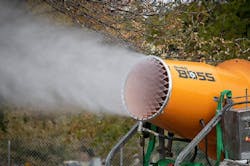Methods for wide-area suppression of surface-borne microbes such as the novel coronavirus—also referred to as SARS-Cov-2 or Covid-19—is a serious consideration for both private industry and public works. Atomized mist technology is currently being used for the safe and consistent distribution of Surface Disinfectant Cleaners (SDCs) over worksites, busy foot traffic areas, and communal spaces. At the forefront of this effort is the DustBoss line of industrial misting cannons, a family of high-powered machines originally designed for large-area dust control.
“The challenge is protecting workers and the public in outdoor spaces by the most effective means possible, using technology that requires the least amount of human contact,” said Mike Lewis, VP of Sales at BossTek. “Sending crews of people out on a regular basis to clean publicly-accessed surfaces is inefficient, costly, and exposes the workers to potential contamination. Studies have shown that the distribution of SDCs evenly across surfaces can effectively reduce the presence of viral and bacterial microbes to mitigate the spread of disease. Atomized mist has proven to be a very effective distribution method.”
Public spaces aren’t the only locations getting treated. Lewis said the company has also supplied equipment for large operations such as mines and material processing facilities that are sanitizing work surfaces before employees return to work. “We’re even seeing some customers who aren’t back up and running yet, but they’re re-purposing their machines to help out other businesses or municipalities, loaning out the equipment to help protect others,” he added. All of the DustBoss models for these applications are available for sale or rent.
Protecting Against COVID-19
The World Health Organization (WHO) differentiates cleaning with disinfecting by defining cleaning as “the removal of visible dirt or particles,” whereas disinfecting “refers to specific measures taken to control, deactivate or kill infectious agents, such as viruses and bacteria.”1
A study testing the effects of SDCs on infectious viruses (Ebola) conducted by the School of Engineering at Tufts University found that “the use of just 0.5% chlorine solutions with a 15-min exposure time is effective in reducing transmission risk.”2 When distributing the proper mixture and dosage to an area during low traffic times, property owners can significantly mitigate the potential risk.
Atomized mist technology disperses millions of tiny treated water droplets over a wide area to achieve effective coverage. The heavy-duty barrel-shaped DustBoss cannons force water through a circular brass manifold fitted with atomizing spray nozzles that fracture the water into tiny droplets 15 to 200 microns in size. The midsized model has a reach of up to 200 ft (60 m). Using a powerful 25 HP fan that produces 30,000 CFM (849.50 CMM) of airflow, the droplets are propelled outward in a cone-shaped pattern. With the adjustable 0 to 50-deg. angle and 359-deg. oscillation settings, the largest model in the fleet can cover up to 280,000 ft2 (31,000 m2)—nearly 6 football fields.
Companies that specialize in outdoor disinfecting services are currently contracted by municipalities and private industries and have already begun successfully implementing this technology in North and South America. The atomized misting cannons can be mounted on water trucks or specified in the company’s Fusion configuration—which includes a trailer-mounted cannon and genset—an effective delivery system for large-scale disinfecting work that’s portable by a pickup truck.
The mobile operations go to parks, community centers, schools, construction sites, and business plazas at opportune times of the day or evening to evenly distribute their proprietary SDCs. Using the optional dosing pump, technicians are able to precisely meter in the right amount of disinfectant to achieve desired concentrations, maximizing efficiency, and minimizing waste.
“People want to work and play in the safest environment possible and this technology can help,” said Lewis. “According to some experts, these types of outbreaks may be more frequent in the future. Having a mechanism for large-area disinfection in place that is easily dispatched to vulnerable areas to quickly stem the tide of infection from surface-borne microbes is a smart move for both public and private entities.”
Sources
1“Guide to Hygiene and Sanitation in Aviation, 3rd edition.” Geneva: World Health Organization; 2009. ISBN-13: 978-92-4-154777-2. https://www.ncbi.nlm.nih.gov/books/NBK310712/
2Lantagne, Daniele, et al. “Determining the Efficacy, Safety and Suitability of Disinfectants to Prevent Emerging Infectious Disease Transmission”. Water, Sanitation, and Hygiene in Humanitarian Contexts, Water Journal, 2018, 10(10), 1397. https://www.mdpi.com/2073-4441/10/10/1397







